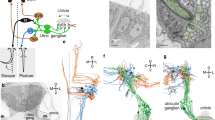Summary
The structural organization of the sensory hairs of the gravity receptors is mainly characterized by the presence of one kinocilium and 40–110 stereocilia on each sensory cell. The spatial arrangement of the kinocilia in relation to the stereocilia presents a polarization, similar to that in the sensory epithelia of the cristae. This polarization, however, is not uniform in the maculae. The direction of polarization varies between groups of several hundred sensory cells. Within one group the sensory cells are all polarized in the same main direction and these groups are considered as functional units.
The apparent stiffness and low metabolic activity of the stereocilia suggest their mechanical transmitter function between the otolithic membrane and the sensory cells.
The presence of modified kinocilia and basal bodies in other sensory systems raises the question of their significance in sensory receptors. Their unmodified structure in the maculae, however, where the basal bodies are almost identical with centrioles, and the presence of one kinocilium with a basal body and an associated centriole in the supporting cells as well, illustrate their unspecific nature. The centrioles, which later probably become basal bodies, are in close relation to the differentiation of apical cytoplasmic structures such as the kinocilium and the cuticula. This is demonstrated by the appearance of those structures at the bottom of the sensory cell, when the centrioles are situated in this part of the cell.
Similar content being viewed by others
References
Barnes, Barbara S.: Ciliated secretory cells in pars distalis of the hypophysis. J. Ultrastruct. Res. 5, 453–467 (1961).
Bos, J. H., L. B. W. Jongkees, and A. J. Philipsszoon: On the action of linear accelerations upon the otoliths. Acta oto-laryng. (Stockh.) 56, 477–489 (1963).
Chapman, G. B., and L. G. Tilney: Cnidocils in nematocysts. J. biophys. biochem. Cytol. 5, 69–78 (1959).
Dahl, H. A.: Fine structure of cilia in rat cerebral cortex. Z. Zellforsch. 60, 369–386 (1963).
Davis, H.: Neural mechanisms of auditory and vestibular systems. Eds.: G. L. Rasmussen and W. F. Windle, p. 21. Springfield, Ill. 1960.
Engström, H., H. Ades, and J. Hawkins: Structur and function of the sensory hairs of the inner ear. J. acoust. Soc. Amer. 34, 1356–1363 (1962).
Fawcett, D. W.: Cilia and flagella, vol. 2, p. 217–297. New York: Academic Press 1961.
Flock, A., and J. Wersäll: A study of the orientation of the sensory hairs of the receptor cells in the lateral line organ of fish, with special reference to the function of the receptors. J. Cell Biol. 15, 19–32 (1962).
Gall, J. G.: Centriole replication. J. biophys. biochem. Cytol. 10, 163–193 (1961).
Gibbons, I. R., and A. V. Grimstone: On flagellar structure in certain flagellates. J. biophys. biochem. Cytol. 7, 697–716 (1960).
Held, H.: Die Cochlea der Säuger und der Vögel. A. Bethe: Handbuch der normalen und pathologischen Physiologie, Bd. 11, S. 467–541. Berlin: Springer 1926.
Henneguy, L. R.: Sur les rapports des ciles vibratiles avec les centrosomes. Arch. Anat. micr. 1, 481–495 (1897).
Jongkees, L. B. W., J. P. M. Philipsszoon, and A. J. Philipsszoon: Clinical nystagmography. Pract. oto-rhino-laryng. (Basel) 24, 65–93 (1962).
Kolmer, W.: Das Gehörorgan. In: Handbuch der mikroskopischen Anatomie des Menschen, Bd. III/1, S. 250–456. Berlin: Springer 1927.
Lasansky, A., and E. de Robertis: Submicroscopic analysis of the genetic dystrophy of visual cells in C3H mice. J. biophys. biochem. Cytol. 7, 679–684 (1960).
Lenhossék, M. v.: Über Flimmerzellen. Verh. anat. Ges. 12, 106–128 (1898).
Löwenstein, O., and J. Wersäll: A functional interpretation of the electron-microscopic structure of the sensory hairs in the cristae of the Elasmobranch Raja clavata in terms of directional sensitivity. Nature (Lond.) 184, 1807–1808 (1959).
Retzius, M. G.: Morphologisch-histologische Studien. Das Gehörorgan der Wirbeltiere. II. Stockholm 1884.
Robertson, J. D.: The ultrastructure of cell membranes and their derivatives. Symp. Biochem. Soc. 16, 3–43 (1959).
Roth, L. E.: Ciliary coordination in the protozoa. Exp. Cell Res., Suppl. 5, 573–585 (1958).
Rouiller, Ch., E. Fauré-Fremiet, et M. Gauchery: Origine ciliaire des fibrilles scléroprotéiques pédonculaires chez les ciliés péritriches. Exp. Cell Res. 11, 527–541 (1956).
Sjöstrand, P. S.: The ultrastructure of the inner segments of the retinal rods of the guinea pig eye as revealed by electron-microscopy. J. cell. comp. Physiol. 42, 45–70 (1953).
Sotelo, J. R., and O. Trujillo-Cenòz: Electron-microscopic study on the development of ciliary components of the neural epithelium of the chick embryo. Z. Zellforsch. 49, 1–12 (1958).
Spoendlin, H.: Submikroskopische Strukturen im Cortischen Organ der Katze. Acta otolaryng. (Stockh.) 52, 111–130 (1960).
Tennyson, V. M., and G. D. Pappas: An electron-microscopic study of ependymal cells of the fetal, early postnatal and adult rabbits. Z. Zellforsch. 56, 595–618 (1962).
Wersäll, J.: Studies on the structure and innervation of the sensory epithelium of the cristae ampullares in the guinea pig. Acta oto-laryng. (Stockh.), Suppl. 126 (1956).
Wolken, J. J.: A molecular morphology of Euglena gracilis var. bacillaris. J. Protozool. 3, 211–225 (1956).
Author information
Authors and Affiliations
Additional information
This work was supported by NASA Research Grant NsC 268—62 to the Harvard University Medical School at the Dept. of Otolaryngology, Massachusetts Eye and Ear Infirmary, Boston, Mass, and by U.S.P.H.S. National Institute of Neurological Diseases and Blindness, Grant nos. B 3447 and B. 3779.
Rights and permissions
About this article
Cite this article
Spoendlin, H.H. Organization of the sensory hairs in the gravity receptors in utricule and saccule of the squirrel monkey. Zeitschrift für Zellforschung 62, 701–716 (1964). https://doi.org/10.1007/BF00341855
Received:
Issue Date:
DOI: https://doi.org/10.1007/BF00341855




